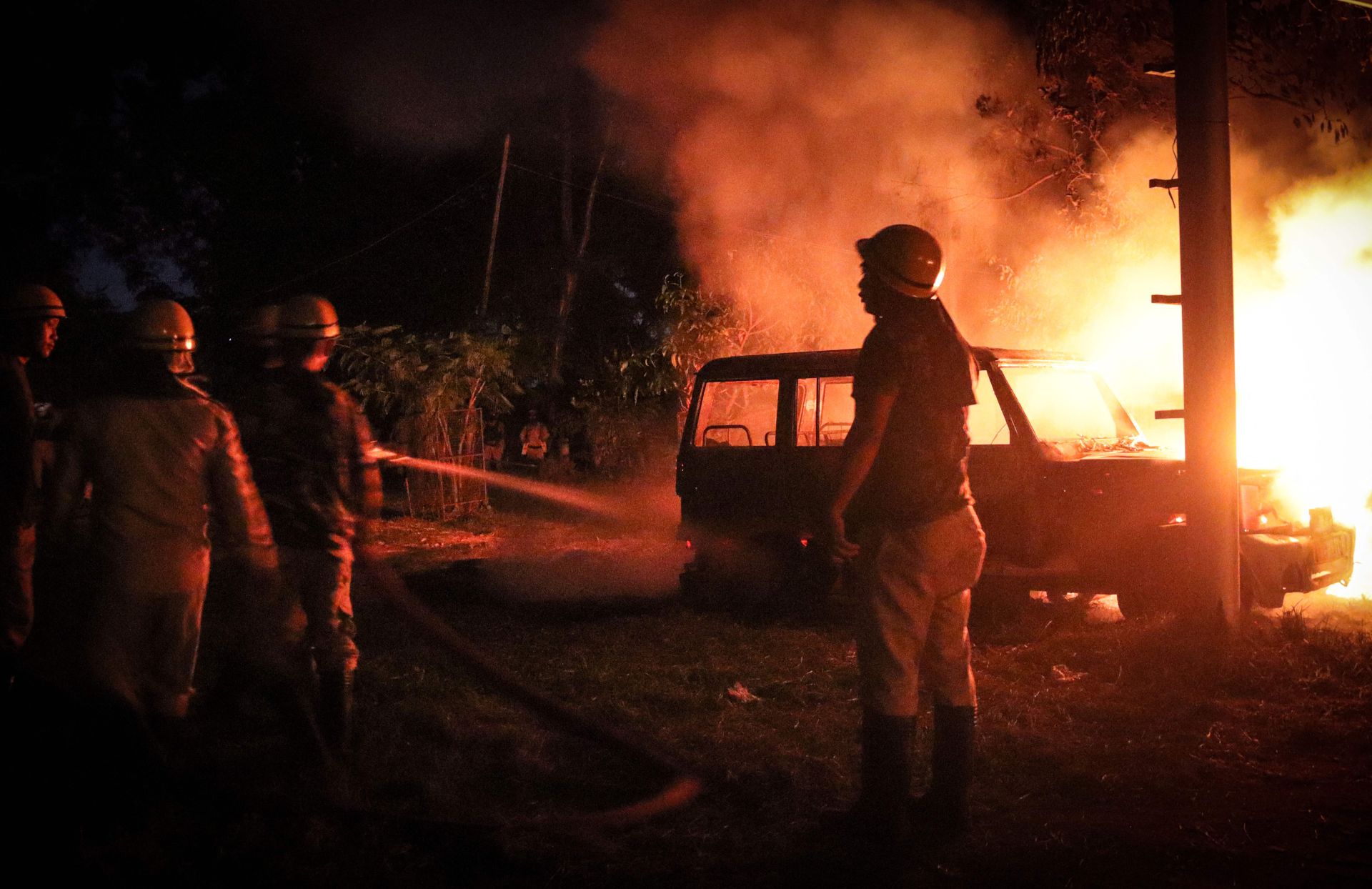“Today is the first day I am coming out with this,” said a missionary, pointing to his sling bag with a Bible, when New Lines met him in August. He feared that if he were frisked, his life could be in danger. One among the four Meitei Christian families in a Hindu-dominated neighborhood of Imphal, the capital of the northeast Indian state of Manipur, the missionary had hardly ventured out since the ethnic conflict erupted in early May and a mob forcefully entered his home and burned all Christian texts, including the Bible, in front of him and his family. Hence, he was reluctant but agreed to meet us at a church 12 miles away, in a predominantly Naga tribe neighborhood. Visibly shaken and scared, he was accompanied by a friend who led the conversation, gauging whether it would be safe for them to speak to us.
On May 3, fighting broke out across Manipur after news spread that a rally held by the All Tribal Students Union of Manipur — which opposed the Manipur High Court’s recommendation to grant Scheduled Tribe (ST) status to Meiteis, the state’s dominant ethnic group — had become violent. The Meiteis, most of whom are Hindu though there are some Muslims and Christians, make up 51% of the population and historically have held more political, cultural and social capital, whereas the minority Kuki-Zo tribes, who make up 14% of the population, are predominantly Christians and have been protected under the ST status, through which the Indian government recognizes historically marginalized tribal communities.
A special provision in the Indian Constitution reserves land in Manipur’s hill districts for these protected tribes. The Meiteis mostly live in the valley and are not allowed to purchase land in the hills. Hence, recently the state government and valley-based civil society organizations have attempted to portray Kuki-Zo tribes as “illegal immigrants” or “not Indigenous” so that their claim to the land could be scrutinized and Meiteis could be granted ST status. These fault lines have led to the recent conflict.
More than 200 people have died in Manipur since the conflict began, with over 65,000 displaced within and outside the state. There have been at least 15 recorded cases of sexual assault. Buffer zones, separating the hills from the valley, are controlled by armed groups that have been revived after first forming during the decadeslong insurgency in Manipur in the 1960s. Even though over 40,000 Indian armed forces personnel are present in the state, firing continues on the edge of the valley and the hills. Mobs have looted more than 4,300 weapons from police armories, mostly in Imphal Valley.
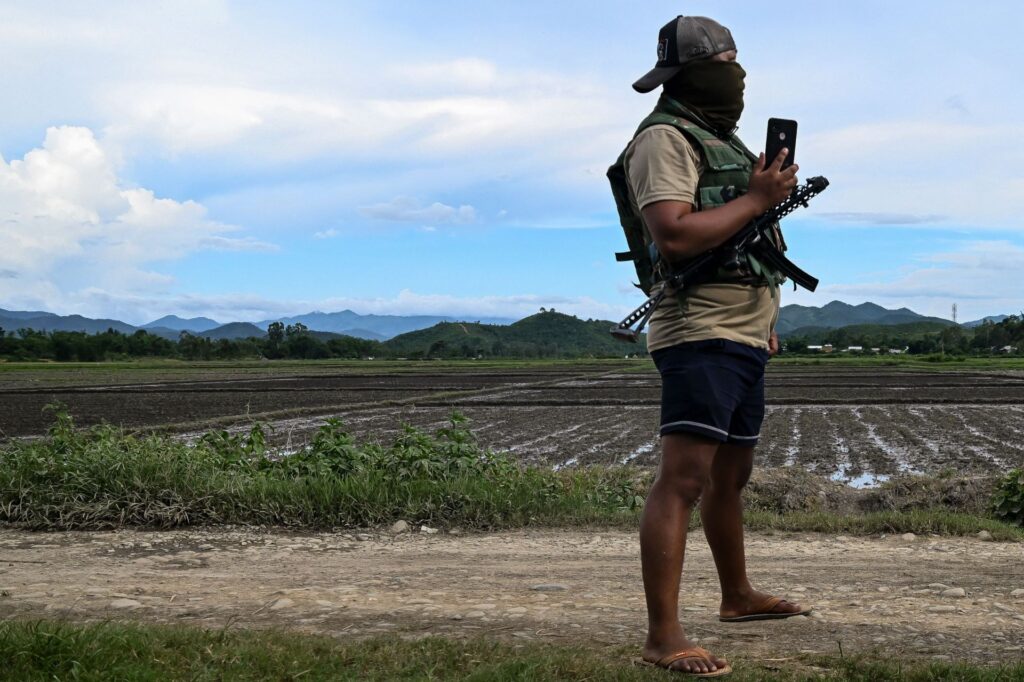
Prime Minister Narendra Modi was forced to break his silence on Manipur in July, when a graphic video showing two tribal women being stripped naked and groped went viral and sparked outrage across India. Several international organizations and diplomats, such as the European Parliament, U.S. Ambassador to India Eric Garcetti and the United Nations’ Special Rapporteurs, had been raising concerns over the conflict but were dismissed by the Indian government, which asked them to not interfere in its internal matters.
While the conflict primarily has been ethnic in nature, between the Meitei and Kuki-Zo tribal residents, there has been a communal element to the violence, especially against Meitei Christians. This aspect of the conflict has been underreported by the media and downplayed by Imphal-based journalists; experts; the ruling Bharatiya Janata Party (BJP) and its ideological parent organization, the Rashtriya Swayamsevak Sangh (RSS); and Oswald Gracias, a cardinal in the Roman Catholic Church. “It has been given a religious twist but it is not a religious conflict. It is between two tribes,” said Gracias, in an undated video statement shared by the BJP in July.
With a population of 300,000, Meitei Christians often call themselves a “minority within a minority.” (Despite being the majority ethnic group in Manipur, Meiteis are an ethnic minority in India.) While there have been tensions in the past between Meitei Hindus and Meitei Muslims, Nagas and Meiteis, as well as Kuki-Zo and Naga tribes, Meitei Christians have avoided conflicts. But during the early days of this unrest, Meitei Christians suffered attacks on their churches and residences, as well as threats and intimidation from village committees and right-wing extremist groups Arambai Tenggol and Meitei Leepun, which are mostly made up of Meitei Hindus and have been organizing themselves militarily over the past two years in an effort to revive Sanamahism, the Indigenous faith followed by the Meiteis before they converted to Hinduism, Christianity and Islam.
In the past five years, the number of Christian converts in the Meitei community has soared. There are over 17 churches in Imphal belonging to the Evangelical Baptist Convention (the largest denomination in Manipur), which exclusively serve a Meitei congregation, said Lalthanglun Guite, a church elder in Lamphelpat, a neighborhood of Imphal. The census reports from 2001 and 2011 show a 62% increase in Christians in the state, with a 15% jump in Hindu-dominated districts in the valley. However, this data is more indicative than conclusive since the migration of Christian tribal people from the hills may have also contributed to this growth. But the increase in the latter’s influence in the state is seen as a threat by the Meitei Hindus and the Sanamahis, who want Meitei Christians to convert to their “original” faith.
New Lines met several Meitei Christian pastors in Imphal and the surrounding Meitei-dominated districts whose churches had been attacked, but they were extremely scared to share their stories. One pastor from the Imphal West district requested that we not speak until we were inside his house. “Many of those who attacked my church live in the neighborhood. We cannot be loud,” he warned. Everything inside his church had been piled up and burned.
A pastor in the town of Thoubal who had agreed to meet us backed out the moment we arrived in his neighborhood. His church was burned down by a mob of more than 2,000, none of whom belonged to his locality, he said. In June, the archbishop of Imphal, Dominic Lumon, said that 249 churches belonging to Meitei Christians had been destroyed in the first 36 hours of the violence.
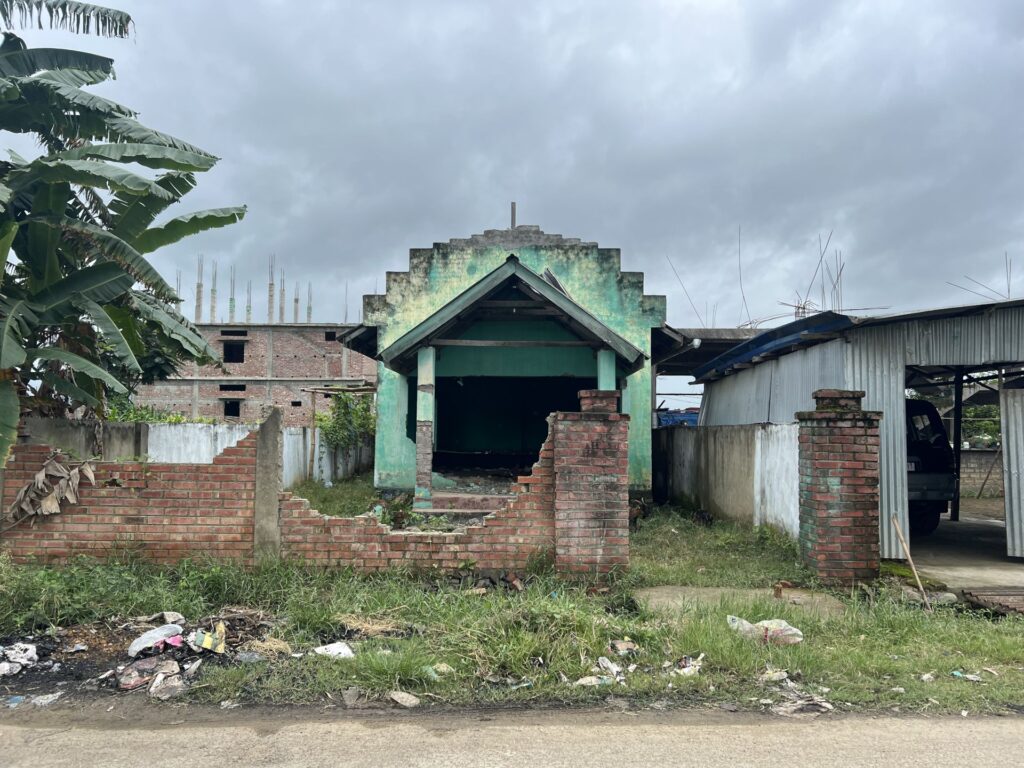
In fact, on Dec. 21 in Awang Leikinthabi village of Imphal West, Premkumar Chingsubam, a pastor, found his house, which he had decorated for Christmas with a tree and artificial snowman, vandalized, when he returned from dinner at his relative’s place. “I felt very unsettled when I saw the way they had destroyed the Christmas decorations,” Chingsubam told New Lines.
The village committee called a meeting the next day where members of the mob, who, the pastor’s nephew alleged, belonged to Arambai Tenggol, also showed up. They acknowledged their role in the attack but did not give a reason for it, the pastor said. Instead, they opened fire, disbursing the meeting before they attacked the pastor, leaving him hospitalized with a bruised forehead, and fractured ribs and hip bone. Photos of him later circulated on social media.
Meitei pastors have also alleged that they were forced to convert to Sanamahism and that an unaccounted number of Meitei Christian families have had to renounce their faith by signing conversion affidavits and burning their Bibles under duress from these extremist groups. New Lines has seen 76 police complaints alleging attacks on Meitei churches, of which six complainants spoke of threats to renounce Christianity and convert to Sanamahism. A senior police officer told New Lines that some of the accused have been charged, although it’s not clear if any arrests were made.
The missionary we met in the Naga-majority neighborhood alleged that he was assaulted, threatened at gunpoint to give up Christianity and told he would be killed if he continued to preach or practice his faith. “They [the mob] told me that by the time they return, I should demarcate a space within my house for Sanamahi deity, failing which they would kill me,” he said. He had filed a police complaint on May 16, stating that “some unknown people numbering about 60” had damaged and burned his property. The Manipur police contacted him recently to say that his case had been sent to the High Court, which would look into the matter.
A Meitei Christian leader told New Lines that he was beaten up by a mob that had pressured him to sign the conversion affidavit. He reasoned with local leaders, promising them that he would stop conducting prayer meetings and would keep his faith to himself. But when he left Manipur for medical treatment, his house was vandalized and locals threatened to shoot him dead after a photo of his battered body was circulated on Kuki-Zo social media groups to highlight anti-Christian atrocities committed by the Meiteis.
Even though he was assured safety by neighborhood elders and members of the district council, when he returned and sought refuge at his relative’s house, a mob surrounded it, then dragged him out and beat him up. “A friend tried to intervene and said if I just signed the conversion document, the issue would die down. I refused.” Eventually, he managed to escape with his wife and children. After walking for miles and hiding in different neighborhoods, they made their way to the state of West Bengal. “I will not return to Manipur,” he said.
A Meitei pastor from Imphal Valley told New Lines that initially the community felt secure thinking that their Christian brethren from the Naga and Kuki-Zo tribes would support them should there be any threats. However, he said that on May 3 they were left in disbelief after churches across the valley were targeted in clashes. “We are like a pendulum right now where the Kukis attack us in the hills and the Sanamahis in the valley.” He, too, fled the state.
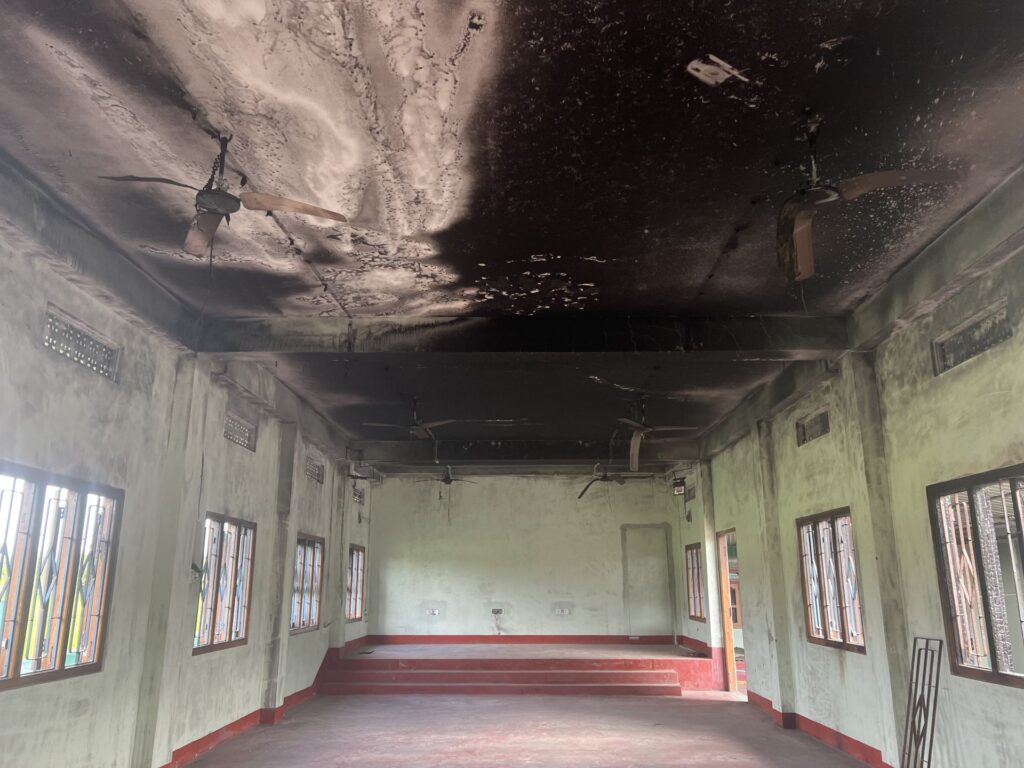
Despite alleged attacks by members of the Kuki-Zo community, there have been attempts to downplay and deny the role of extremist Sanamahi groups in the attacks against Meitei Christians and blame them on the Kuki-Zos. During a press conference led by the Meitei Christian Churches Council (MCCC) in Delhi in July, Meitei organizations alleged that all properties and churches of Meitei Christians were only destroyed by Kuki-Zo tribal people. However, Lumon said that there was no evidence or reports that Meitei churches were destroyed by Kuki-Zos in the hills.
Philem Rohan Singh, a popular Meitei Christian travel vlogger who has become the face of the community, told New Lines that “people from these groups [Meitei Leepun and Arambai Tenggol] may have been involved but largely this has come from the Leikai [village neighborhood] committees exacting personal revenge from the Christian families.” Though Meitei Christian pastors did accuse village chiefs and district council leaders of attacks, they also alleged that they belonged to Hindu and Sanamahi-dominated committees working in cahoots with the extremist groups.
Rohan Singh further stated that neither Arambai Tenggol nor the “titular king” had given any personal instructions to burn down churches. By “titular king” he was referring to Maharaja Leishemba Sanajaoba, the grandson of Maharaja Bodhchandra Singh, who ruled over the state and was coerced to sign the merger agreement with the Union of India in 1949. Even though the royal family does not rule over Manipur, Sanajaoba continues to lead the family and has played an instrumental role in reviving Sanamahism and supporting groups like Arambai Tenggol in the past two years with combat training and encouraging the practice of their rituals.
Until 2020, Sanajaoba’s influence was limited to his royal lineage, and he was the “symbolic and spiritual head of many ritualistic traditions of the old Manipur kingdom,” wrote veteran journalist Pradip Phanjoubam in The Telegraph India. But he had no real power, as acknowledged by the king himself, till he was nominated as a member of the Rajya Sabha (the upper house of Parliament) in 2020 by the BJP, which hoped to harness this new surge of energy in the Indigenous people’s movement.
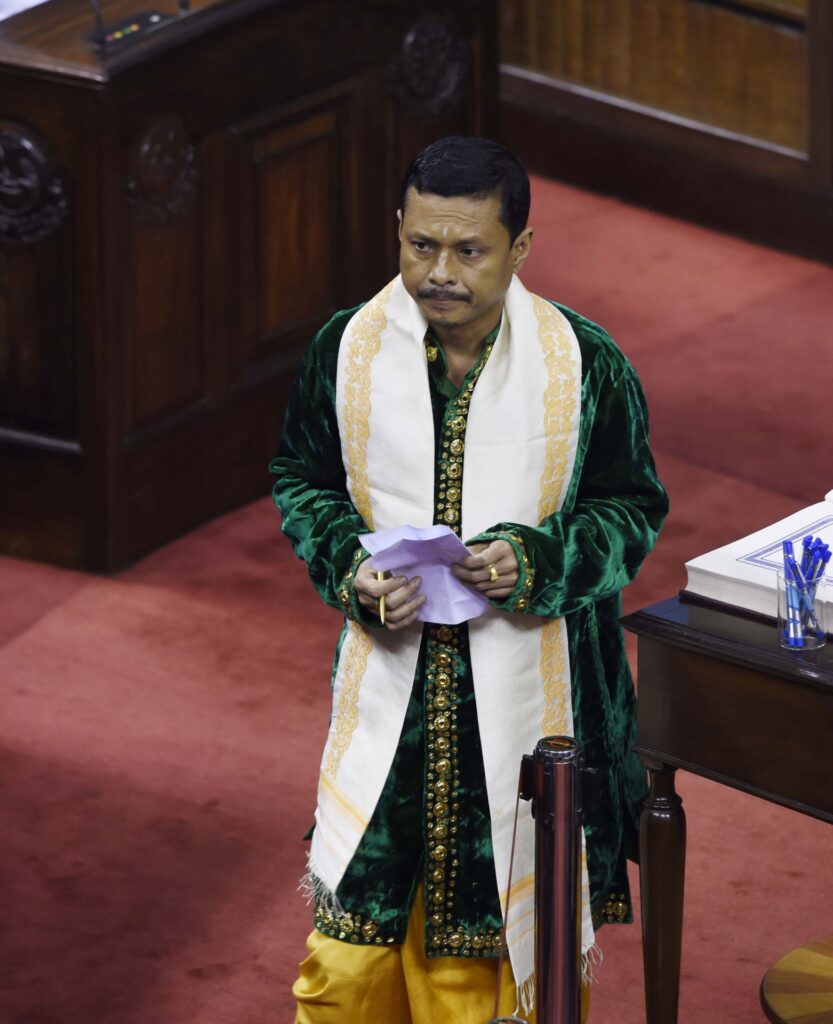
Rohan Singh also contested the “communal” narrative — that there were fault lines within the Meiteis — alleging instead that the churches were destroyed by the Kuki-Zos. He shared a list of 13 such churches, of which New Lines verified that 10 were still standing, unharmed.
Over the past seven decades, Hindu nationalist organizations have pushed for the revival of Indigenous faiths that tribal communities in India’s northeast region followed before the majority converted to Christianity. Even though Hindus make up 54% of the population in this region, they are a minority in four of the seven states that make up the northeast. Hence, the region is of special interest to the Hindu nationalist organizations that want to bring the converted Christian tribal people into the Hindu fold by promoting Indigenous faiths. Recently, the RSS has also started demanding that the ST status of tribal people should be revoked unless they return to their Indigenous religion or Hinduism.
Moreover, Hindu right-wing organizations have also used mythology to link the northeast region with Hinduism. For instance, in a 2018 speech at the annual Madhavpur fair in Gujarat where the union of Lord Krishna and his goddess wife Rukmini is celebrated, Manipur Chief Minister Biren Singh said that Lord Krishna had abducted “our girl” (when she was being forcefully married by her brother) and made a connection between Rukmini’s origins and the Idu Mishmi tribe in Arunachal Pradesh. Similarly, claims have been made that princess Chitrangada, whom Pandava Prince Arjuna had married in the Hindu mythological epic Mahabharata, was from Manipur.
In Manipur, before converting to different religions, Meiteis followed Sanamahism and regarded Lainingthou Sanamahi as the creator and controller of the universe. But when King Pamheiba of the Kangleipak kingdom, which ruled over the valley in the 18th century, was inspired by the teachings of a Bengali Brahmin preacher from Sylhet (in present-day Bangladesh), he forced his subjects to convert to Hinduism and adopt the Bengali script. During that period, several Sanamahi deities and scriptures were destroyed, Hindu preachers banned the practice of the old Indigenous faith, and the seven clans of the Meitei dynasty were included in the Hindu caste system.
In the past decade, however, some Meiteis have sought to revive their Indigenous roots. According to Vidyapati Senjam, a senior ideologue of the Sanamahi religion and vice president of the Lainingthou Sanamahi Temple Board, Meiteis Hindus have increasingly readopted Sanamahism, with younger generations embracing it more willingly than the older ones. In 2021, the Manipur government also reverted to the Meitei Mayak script, which was replaced around the advent of Hinduism, stoking controversies while trying to claim tribal areas in the hills as sacred protected sites for Sanamahi Meiteis.
While the adoption of Samanahism by Hindus has been seamless, Meitei Christians have firmly opposed this wave, particularly because of the way that ethno-nationalist groups have been propagating it. There are several videos on Facebook of Arambai Tenggol demonstrations in which young Meitei men dressed in black sport a red insignia of three horsemen charging into battle, reminiscent of the image of the cavalry of the erstwhile Kangleipak kingdom wielding a poisonous dart. They march down highways or market areas distributing pamphlets and chanting slogans on restoring the glory of the old kingdom.
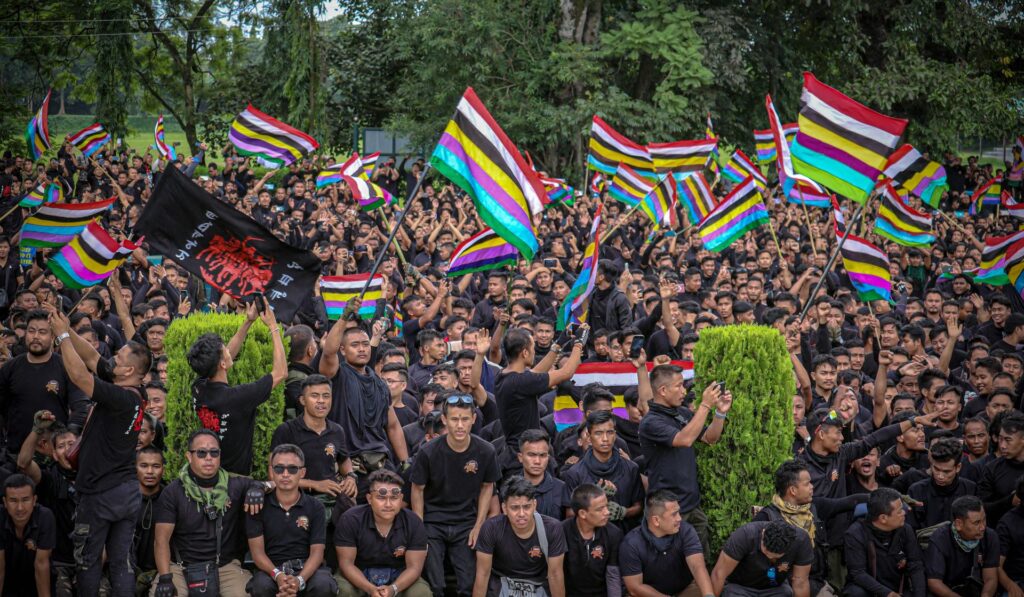
Moreover, Meitei pastors have alleged that the terms of conversion and its enforcement have been different for Hindus and Christians. Hindus don’t have to sign an affidavit; they just need to keep the southwest corner of their home empty, dedicating it to Lainingthou Sanamahi, alongside Hindu deities. But for Meitei Christians, the conversion entails personally burning the Bible, removing all signs of Christianity from their homes, joining meetings and signing a legal affidavit declaring that they have converted to Sanamahism, said the pastor from Imphal Valley. Senjam told New Lines the reason for the difference was because most Meitei Hindus practice certain rituals of Sanamahism, unlike the Abrahamic faiths.
Several leaders in Manipur have told New Lines that the BJP leadership has applied pressure on Meitei Christian leaders to convert to Sanamahism. At least two public personalities said they were summoned to meet the chief minister in 2022 after videos of them speaking about their faith went viral. One of them alleged that in a meeting where Meitei Leepun chief Pramot Singh was present, they were indirectly pressured to abandon their Christian faith.
A member of the Legislative Assembly (MLA) who belongs to BJP and did not want to be identified told New Lines that the chief minister had pressured Paonam Brojen Singh, a Meitei Christian politician and BJP MLA, to convert to Sanamahism through his aides. “Both Sanajaoba and Leishanthem Susindro Meitei [another BJP MLA] were also present,” they said. Another pastor alleged that MLA Mayanglambam Rameshwar Singh, who belongs to the National People’s Party, offered him money to convert in 2022.
Responding to these allegations, both Susindro Meitei and Rameshwar Singh told New Lines that they were “not true” and one shouldn’t believe in these “false rumors.” Biren Singh and Sanajaoba had not responded to our emails at the time of publication.
Meanwhile, the names of Biren Singh, Sanajaoba and Yasobanta Sharma, the acting president of the Manipur chapter of Vishwa Hindu Parishad, a prominent Hindu right-wing organization, on the plaque of a new building within the Sanamahi Temples complex in Imphal further showed a close working relationship between Meitei leaders and Hindu nationalist organizations.
As for the conflict with Meitei Christians, Senjam said that the problem isn’t with any particular faith but with how community members speak about Sanamahism. “Tribal Christians don’t talk down about our religion, but Meitei Christians do,” he said. He was referring to comments made in April by the Meitei Rev. Takhellambam Ramananda during a gospel outreach program in Imphal, when he spoke ill of certain tenets of Sanamahism. The preacher received a lot of criticism and was briefly arrested, but his comments sparked widespread protests led by the Arambai Tenggol. Even Sanajaoba posted on social media, threatening to “skin him alive if he doesn’t apologize.”
Similarly, statements made by Brojen Singh, the lone Meitei Christian representative in the state assembly, had also irked Meitei Hindus and Sanamahis. The BJP politician had organized a “peace rally” in March, involving the Meitei Christian community, to support the government’s “war on drugs” campaign, aimed at stopping poppy cultivation in the hills, which mostly involved Kuki-Zo tribal people.
But he devoted most of his speech to commending how far tribal people had come by adopting Christianity. “Earlier, we thought the tribals to be fools. But look at them now,” he said. “Because of Christianity, they have advanced much ahead of us in all important fields, controlling 92% of the state resources today. Now we [Meiteis] are the tribal fools.” He further blamed the “old religion” for holding back the Meitei community, which did not go down well with the Sanamahi groups and Meitei Hindu leaders.
“Such statements are bound to cause anger among the youth,” said Senjam, attributing the statements for provoking mobs to go after Meitei Christians and their churches.
The Rev. L. Manga, the joint secretary of the All Manipur Christian Organization, told New Lines that Christian leaders had told Brojen Singh not to hold this rally, since it could cause more trouble. “But he insisted that this wasn’t about tribals but to show their strength as Meitei Christians,” said Manga.
The rally was an important political ploy for Brojen Singh to display the huge turnout of the Meitei Christian community, which ran into the thousands (although some claim that as many as 60,000 Meitei Christians were present). “It was a response to the pressure he was put under to give up Christianity,” said one BJP MLA, who didn’t want to be named. New Lines made several attempts to reach Brojen Singh for an interview, but he didn’t respond. Christian leaders from the tribal and Meitei communities said that he has gone into hiding since the conflict began. On May 28, a mob of between 3,000 and 4,000 people attacked his house in the Wangjing Wangkhei neighborhood of Thoubal and the Wangjing Baptist Church that he had built.
A Meitei Christian leader from Bishnupur town in Manipur told New Lines that Meitei Christians should not be making such provocative statements about the majority community and blamed Ramananda and Brojen Singh for the current predicament of Meitei Christians. He said that when Meitei churches were being burned, he told his friends not to write or publicize about it because antagonizing the majority would only work against them.
“This is the time to be silent and pray,” he said, while adding that an Arambai Tenggol cadre told him to remove the verses of the Bible that had been painted inside his compound.
Meanwhile, Senjam said efforts are ongoing to ensure that attacks against Meitei Christians don’t happen again.
Since the onset of the violence, all programs at the churches of the pastors New Lines spoke with had stopped, but prayer fellowships have continued and are taking place over conference calls.
Meanwhile, Rohan Singh told New Lines that a resolution had been reached with the right-wing Sanamahi groups to allow Meitei Christians to resume services in the valley. “Meitei Leepun and Arambai Tenggol are ready to do a press release. Now that we have their assurance, many Meitei pastors have already started their church service,” he said. However, no such release was made at the time of this writing.
The displaced pastors didn’t buy into the claims of compromises, even if statements were coming from those in their own community. Rohan Singh “might be under threat to say that,” said a pastor of an independent church in a rural district in the valley who had to flee Manipur with his family to an undisclosed location in the Northeast region after his church was looted and burned down and his house was vandalized on May 4. “If we go back to Manipur, something bad may happen to us. [Also] if a resolution was reached, they would have announced it in the news, but both central and state governments are quiet.”
The pastor who fled to West Bengal said that he had stopped all worship activities for a while and had started worshiping Pakhangba (one the most powerful Sanamahi gods). But he has stopped short of signing the conversion affidavit. “I could not remove Jesus from my heart. When the mob dragged me out of the house, they shouted that I would be killed like Jesus,” he said.
A member of the district council where this displaced pastor came from told New Lines that attacks on Meitei Christians were unfortunate and “everybody was charged up those days,” but it is “safe” for displaced church leaders to return.
Organizations like the MCCC have been making efforts to rebuild trust with Meitei civil society groups by distancing themselves from Kuki-Zos. For instance, when a petition was filed against Meitei Leepun and Arambai Tenggol at the Supreme Court and a list of 121 churches burned or destroyed across ethnic communities was provided, the MCCC strongly opposed the inclusion of 70 Meitei churches in it and disassociated itself from the tribes.
The Bishnupur pastor said that when the churches are rebuilt, they should reflect Meitei culture and not have any Kuki-Zo influence, by which he meant that they should not be taking the “eager” monetary assistance often offered by Kuki-Zos and Nagas to Meitei Christians to build churches.
A pastor in Assam told New Lines that several Meitei Christian leaders like him have been part of several meetings where they have been reassuring Meitei groups that they have no association with the Kuki-Zos.
“Lord Jesus does not only belong to the Kukis. He belongs to all of us,” he said. “If he was only for Kukis, we would not have worshiped him.”
Become a member today to receive access to all our paywalled essays and the best of New Lines delivered to your inbox through our newsletters.




